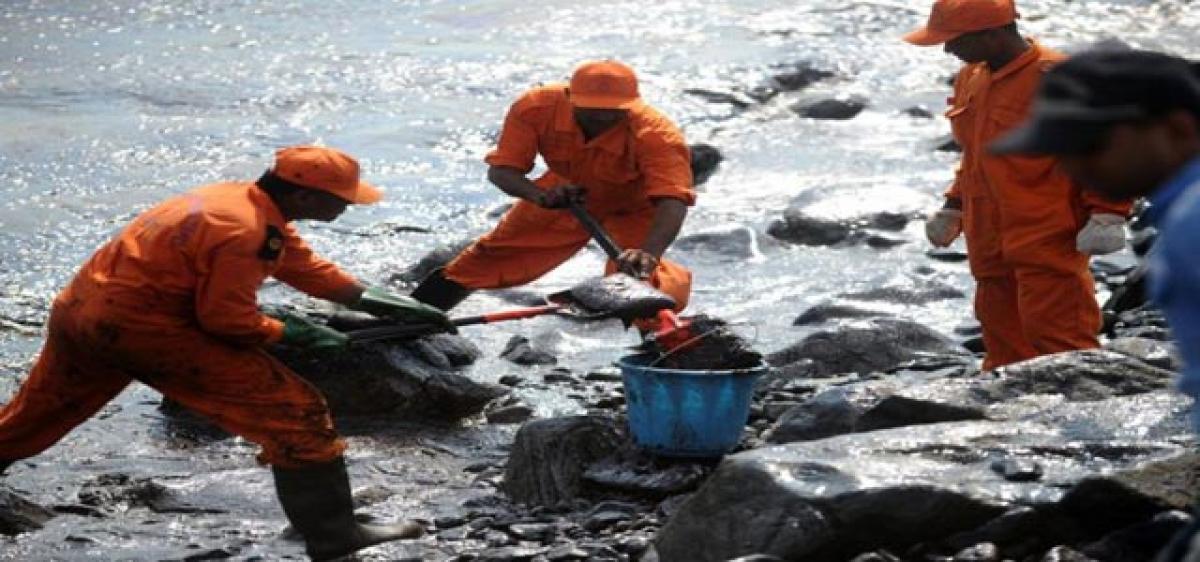Live
- NASA Tracks Five Giant Asteroids on Close Approach to Earth Today
- Pushpa 2 Hits ₹1000 Crore in 6 Days: How It Compares to Other Top Indian Films
- Vivo X200 and X200 Pro Launched in India: Price, Specifications, and Features
- Nitin Gadkari Admits Feeling Embarrassed at Global Summits Over Rising Road Accidents in India
- Comprehensive Review on Indiramma Housing Survey and Welfare Initiatives Conducted via Video Conference
- Jogulamba Temple Records Rs 1.06 Crore Hundi Revenue in 150 Days
- Opposition Slams ‘One Nation, One Election’ Bill as Anti-Democratic; BJP Allies Support the Move
- Celebrate Karthigai Maha Deepam Virtually with Sri Mandir’s LIVE Darshan Experience
- BJP Extends Support to Samagra Shiksha Abhiyan Employees' Strike, Demands Immediate Regularization and Welfare Benefits
- Dr. M. Priyanka Stresses Quality Education, Nutritious Meals, and Cleanliness in Schools
Just In

Coast Guard has repeatedly brought up the need of Local Contingency Plans (LCPs) for the proper functioning of the national plan National Oil Spill Disaster Contingency Plan.
Coast Guard has repeatedly brought up the need of Local Contingency Plans (LCPs) for the proper functioning of the national plan National Oil Spill Disaster Contingency Plan. The recent oil spill off the Chennai coast makes this painfully obvious The Chennai oil spill which occurred after a collision between two tankers at the Kamraj Port in Ennore brings back into sharp focus India’s preparation to handles disasters from its port developments.
The National Oil Spill Disaster Contingency Plan (NOS DCP) was adopted way back in 1996. The plan has been reviewed and revised periodically to reflect international safety standards and provisions according to the Union Ministry of Shipping and Indian Coast Guard, in charge of oversight and implementation.
The review process has been going on for two decades now, but one of its most important requirements is still virtually absent. The Indian Coast Guard has repeatedly brought up the need of Local Contingency Plans (LCPs) for the proper functioning of the national plan. LCPs are state-level plans for containing and cleaning oil spills which work in coordination with port-level plans and state disaster management units.
Until the most recent annual meeting of the NOS DCP held in August 2016, only Goa out of the 9 states/union territories that house major ports had furnished a plan that had been approved and set into action. Without this intermediate level of planning, the broader national plan becomes unattainable and is only worth the paper it has been printed on. The most recent oil spill off the Chennai coast makes this painfully obvious.
But what rattles more is that this is not the first spill to have occurred in India’s waters in the recent past. The west coast between Maharashtra and Gujarat is the most prone due to high concentration of oil refineries. Mumbai alone has seen three major spills since 2010 in its vicinity and yet the state’s LCP remains in the works. According to the Oil Spills India Report from 2016, few tankers or ships go down in Indian waters every year and annual spillage up to several hundred tonnes is not uncommon.
The shipping sector has grown in the last 20 years. Between 1994 and 2014, traffic handled at the 11 major ports in the country grew nearly three folds from 197 million tonnes to over 550 million tonnes. A significant portion of this increase has been attributed to the energy sector. Oil, India’s most important energy source after coal, accounts for more than a third of the country’s energy needs.
Eighty per cent of India’s 227 million metric tonnes of crude oil is sourced through imports and is handled at one of 7 port cluster ports. The Gujarat cluster of ports alone handles 65 per cent of this while the other ports handle between 4-8 per cent each. Petroleum, oils and lubricants together constitute 36 per cent of the total traffic at Indian ports.
According to the Ministry of Shipping, the demand for oil will nearly double by 2025 and India’s ports will likely play a major role in realising India’s growing energy needs. The shipping ministry has undertaken the Sagar Mala Project, worth Rs 1000 crore, to power this expansion. The Sagar Mala Project is aimed at "transforming existing ports into modern world class ports and integrate the development of ports, the Industrial clusters and hinterland and efficient evacuation systems through road, rail, inland and coastal waterways resulting in Ports becoming the drivers of economic activity in coastal areas” according to the ministry.
The project includes developing six “mega ports”, one each in Kerala, Tamil Nadu, Andhra Pradesh, Karnataka, Maharashtra and West Bengal. This includes expanding oil-handling capacity at ports as well as increasing coastline use for oil transportation as detailed in the Cargo Traffic Projections and Logistics Bottleneck Report prepared by Ministry of Shipping and Indian Ports Association.
The risk of oil spills is bound to increase as more ports and coastal transportation routes are developed to handle petroleum. But from the snail pace of procedural movement shown by state and port officials in preparing contingency plans and conducting the required periodic drills, it is certain that environmental protection is not seen as much of bottleneck for development. (Courtesy: Down To Earth)

© 2024 Hyderabad Media House Limited/The Hans India. All rights reserved. Powered by hocalwire.com







